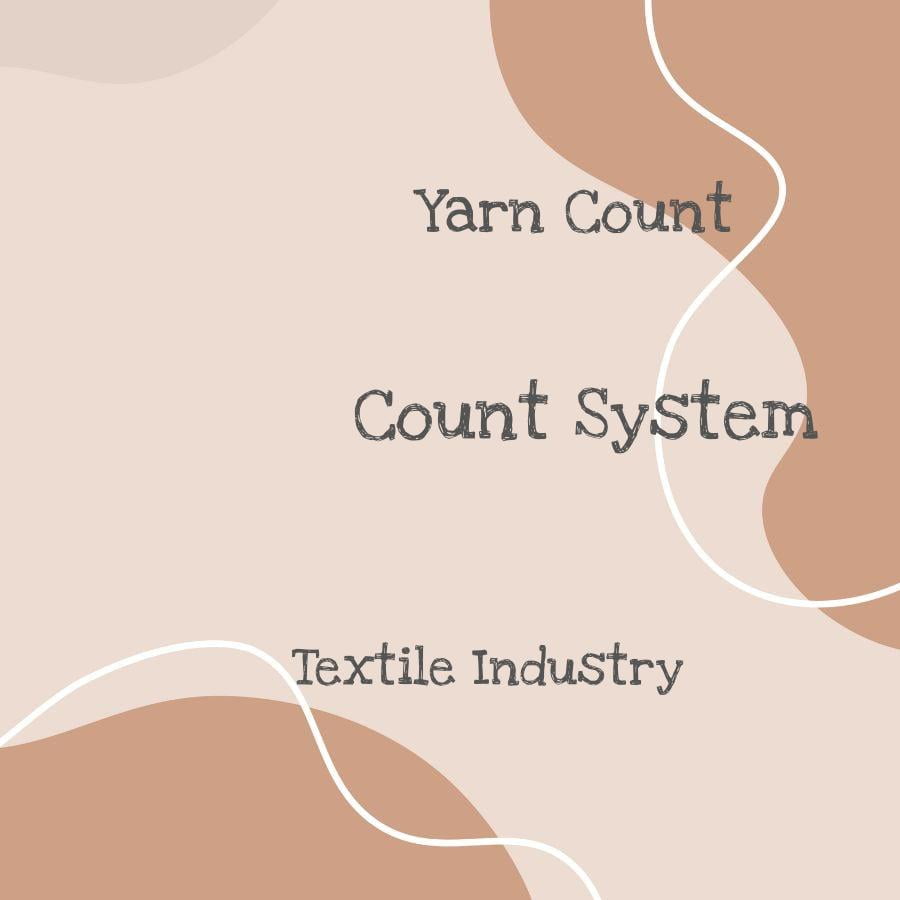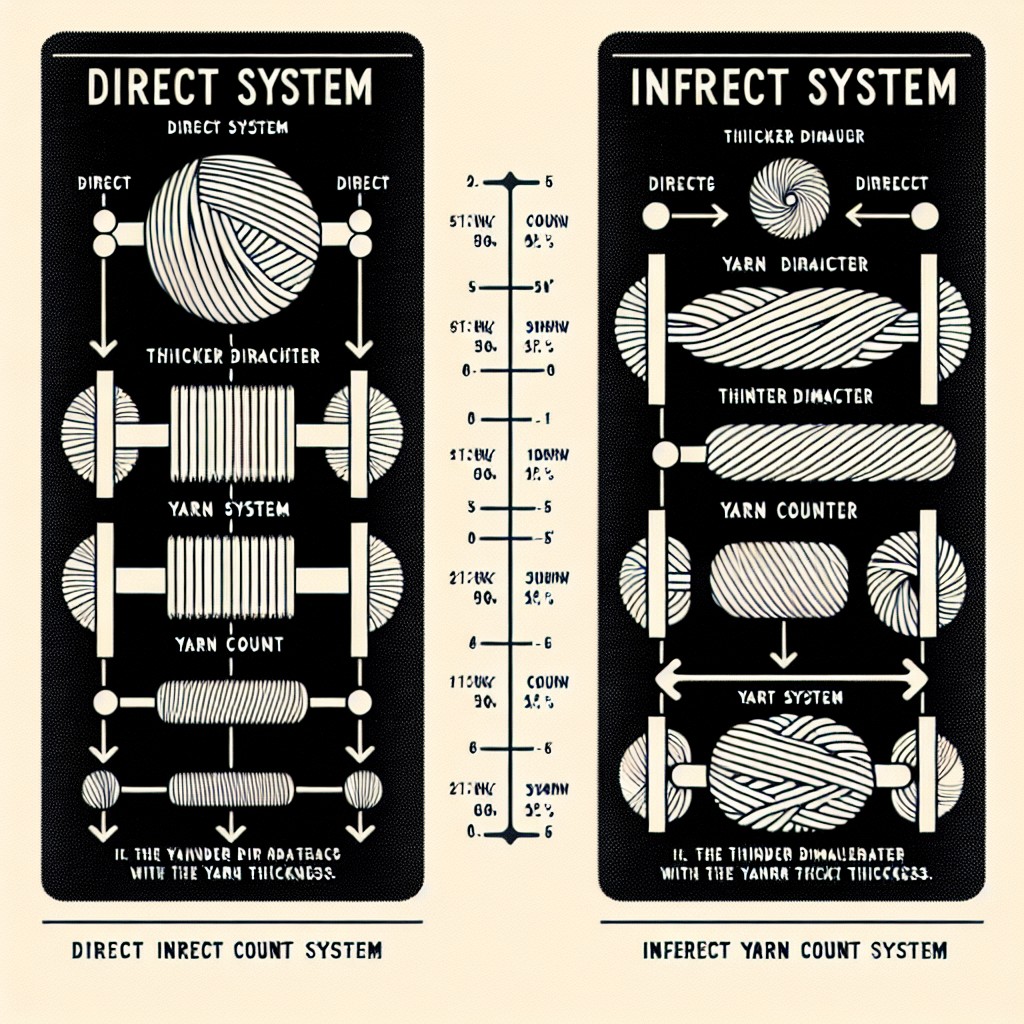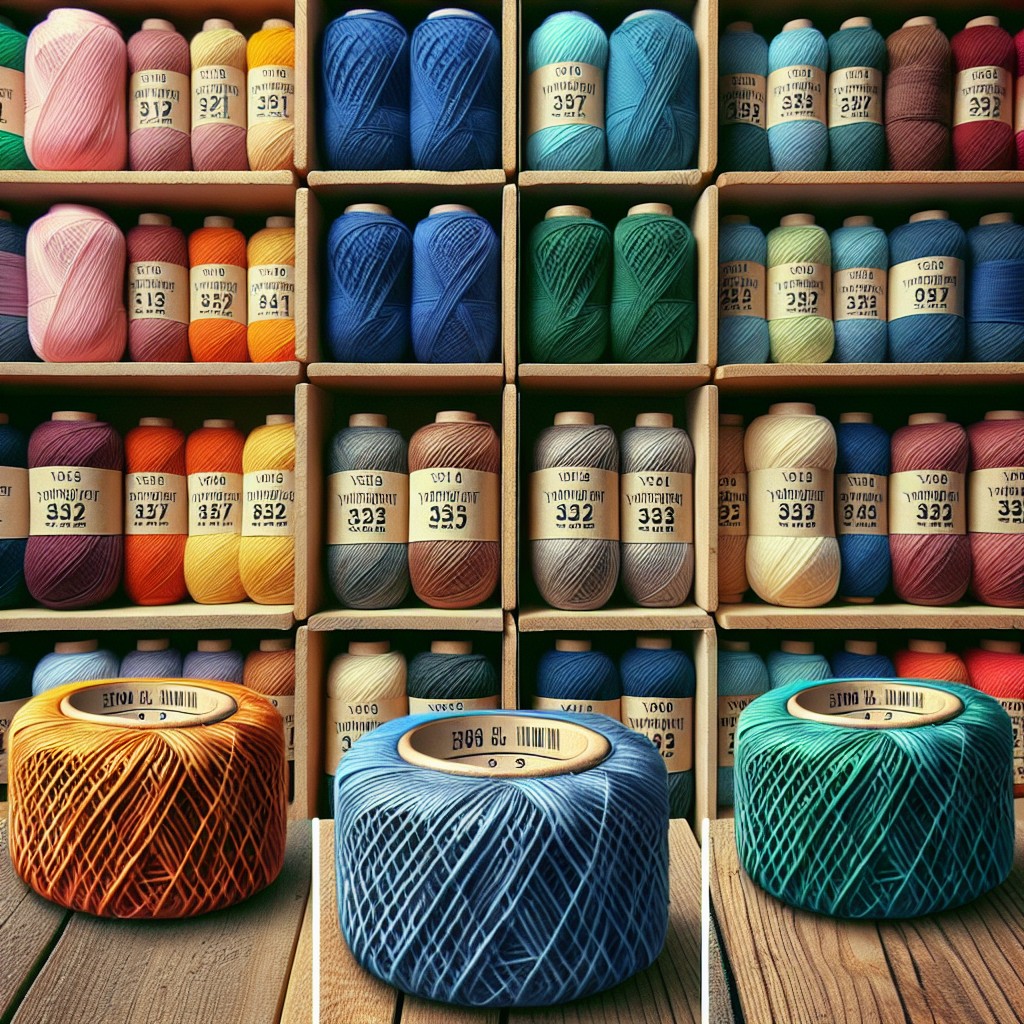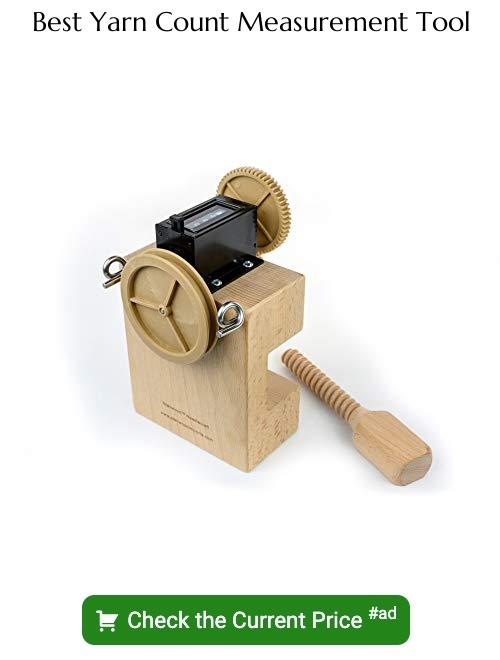Discover the fascinating world of yarn counts as we unravel the various types and their unique characteristics in this informative blog post.
Are you a yarn enthusiast who loves to crochet or knit? If so, then you know that choosing the right yarn is crucial to creating beautiful and durable projects. One important aspect of yarn selection is its count, which refers to the thickness or weight of the yarn.
Understanding different types of yarn counts can help you achieve your desired results and make your crafting experience more enjoyable. In this article, we’ll explore various types of yarn counts and their characteristics so that you can make informed choices when selecting your next project’s materials.
So grab your hooks and needles, let’s dive into the world of yarn counts!
Introduction to Yarn Count

Yarn count is a term used to describe the thickness or weight of yarn. It is an essential factor in determining the quality and characteristics of a particular type of yarn.
The count system varies depending on the country, region, or industry where it’s being used. Understanding different types of yarn counts can help you choose suitable materials for your project and achieve desired results.
The most common types include direct and indirect systems, English count system (used mainly in woolen industry), Tex Count System (used mostly in North America), Denier Count System (commonly used for synthetic fibers like nylon), Metric Yarn Count System (widely accepted globally) among others.
In this article, we will explore each type more closely so that you can make informed choices when selecting your next project’s materials. We’ll also discuss factors affecting yarn counts such as fiber content, spinning method employed during production as well as practical applications within textile industries.
Direct and Indirect Count Systems

The direct system measures the length of a fixed weight of yarn, while the indirect system measures the weight of a fixed length of yarn.
The direct count system is commonly used in countries like India, Pakistan, and Bangladesh for cotton counts. In this method, one end (a single strand) is taken from a bundle or hank and weighed on an electronic balance to determine its mass per unit length.
On the other hand, indirect counting systems are more prevalent in Europe for woolen counts such as Worsted Count System or Bradford Count System where it’s difficult to get uniformity in thickness throughout each strand due to natural variations within fibers.
Understanding these different types of counting systems can help you choose which one will work best for your project needs based on factors such as fiber type and desired outcome.
English Yarn Count System

It measures the weight of a yarn in terms of its length per unit mass (yards per pound). The higher the number, the finer and lighter weight is your yarn.
This system was developed in England during medieval times when wool was spun by hand. The term “worsted” comes from Worstead village in Norfolk where this type of woolen fabric originated.
Today, it’s commonly used for worsted-weight knitting and crochet projects such as sweaters, blankets or scarves. However, it can be challenging to use with other types like cotton because they have different densities than wool fibers.
Understanding how to read an English Yarn Count label will help you choose suitable materials for your project accurately. For example: 4/2 means four plies twisted together with each ply having two strands; 8/1 means eight single strands twisted together into one strand; while 16/3 indicates sixteen plies twisted into three-strand groups.
Tex Count System

This system is commonly used in Europe and Asia, especially for synthetic fibers such as polyester, nylon, and acrylic. The higher the Tex number, the thicker or heavier the yarn.
Tex count can be easily converted to other systems like denier or metric counts by using conversion formulas. For example, one denier equals approximately 9 tex while one metric count equals approximately 590 tex.
Understanding different types of yarn counts can help you choose suitable materials for your projects based on their thickness and weight requirements. Whether you prefer natural fibers like cotton or wool or synthetic ones like acrylics and polyesters – knowing which type of counting system to use will make all the difference when it comes to achieving your desired results.
Denier Count System

It is commonly used for synthetic fibers such as nylon, polyester, and rayon. The denier count refers to the weight in grams of 9,000 meters of yarn.
For example, if a fiber weighs 18 grams per 9,000 meters lengthwise or crosswise it would be considered an 18-denier fiber.
This system was developed by French scientist Jean-Baptiste d’Ortigue in the mid-20th century and has since become widely adopted across the textile industry.
Understanding different types of yarn counts can help you choose the right materials for your project based on its desired characteristics such as softness or durability.
Metric Yarn Count System
It is also known as the “Count System” or “Metric Count.” This system provides a more accurate measurement of yarn thickness and allows for easier comparison between different types of yarn.
In this count system, the higher the number, the finer and thinner the yarn. For example, a 50-count metric thread will be thicker than an 80-count metric thread.
The Metric Yarn Count System is commonly used in Europe and Asia but has gained popularity worldwide due to its accuracy.
When selecting your next project’s materials, it’s essential to consider which type of count system you prefer based on your desired outcome. If you’re looking for lightweight garments or accessories with intricate details such as lacework or cables, then choosing finer threads with higher counts may be ideal.
Worsted Count System
It measures the weight of a yarn by counting the number of hanks (a length measurement) per pound. The higher the number, the finer and lighter weight the yarn will be.
Worsted count is commonly used for woolen and worsted fabrics, as well as for knitting and crocheting projects such as sweaters, scarves, hats, gloves etc. This system provides an accurate way to determine how much yardage you need to complete your project.
When selecting a Worsted Count System yarn for your project it’s important to consider its characteristics such as texture or fiber content which can affect drape or stitch definition among other things.
Cotton Count System
It is widely used in the textile industry, especially for cotton fabrics and garments. In this system, the higher the number, the thinner and finer the yarn.
For example, if a particular fabric has 40 counts per inch (CPI), it means that there are 40 hanks of yarn weighing one pound each in one inch length of fabric. Similarly, if a fabric has 60 CPI or more than that then it will be considered as fine quality.
This count system originated from England during early industrialization when spinning mills were producing large quantities of cotton thread for weaving into cloth. The Cotton Count System was developed to standardize measurements across different mills and ensure consistency in production.
Today this counting method is still relevant because it helps manufacturers determine how much raw material they need to produce specific types of fabrics or garments with desired characteristics such as softness or durability.
Understanding different types of yarn counts can help you choose appropriate materials for your projects based on their intended use and desired outcome.
Linen Count System
It was originally used to measure linen yarn, but it is now also used for cotton and other fibers. The higher the linen count, the finer and thinner the yarn will be.
This system can be confusing because it uses a different unit of measurement than most other systems. However, once you understand how it works, you can easily convert between linen counts and other types of counts.
If you’re working on a project that requires fine or delicate fabric such as lacework or doilies, then using yarn with high linen count would be ideal for achieving your desired results. On the contrary if your project requires thicker fabrics like blankets or scarfs then lower linens counts are more suitable.
Dewsbury Count System
It was developed by John Brooke and Sons, a textile company based in Dewsbury, West Yorkshire. This system measures the weight of 1,000 yards of yarn in pounds (lb).
The higher the number of pounds per 1,000 yards (ypp), the finer and lighter the yarn.
The Dewsbury Count System is commonly used for woolen and worsted spun yarns. It’s also used to measure silk threads as well as cotton threads for embroidery purposes.
Understanding different types of yarn counts can be overwhelming at first but it’s important to know which one works best for your project needs.
Bradford Count System
It measures the number of hanks (840 yards) per pound of yarn, with higher numbers indicating finer and thinner yarns. This system is commonly used for woolen and worsted spun fibers.
Named after its place of origin, Bradford in West Yorkshire, England, this count system was developed by James Holden in 1887 to standardize woolen spinning processes. The Bradford Count System has since become widely adopted across the textile industry as it provides an accurate measurement for determining thread density.
If you’re working on a project that requires fine or delicate threads such as lacework or lightweight garments like shawls and scarves, then using a lower number on the Bradford scale would be ideal. On the other hand, if you’re creating heavier fabrics like blankets or sweaters where durability is key – opting for higher numbers would be more appropriate.
New English Count System
Unlike the original system, which only measures yarn thickness based on length and weight, this new method also considers the number of twists per inch (TPI) in determining yarn count. This makes it more accurate and reliable for measuring finer counts.
The New English Count System has become increasingly popular in recent years due to its precision and versatility. It is commonly used for high-quality woolen fabrics such as tweed or flannel that require a soft hand feel with excellent drape characteristics.
As a crafter or textile enthusiast, understanding different types of yarn counts can help you choose materials that are best suited for your project’s needs. The New English Count System offers an alternative approach to measuring yarn thickness accurately while considering other essential factors like twist density.
Whether you’re creating cozy blankets or stylish garments, selecting the right type of yarn can make all the difference in achieving your desired results.
Decimal Reduction System
It is commonly used in the United States and Canada for cotton, wool, and synthetic fibers. The DRS assigns numbers to indicate the number of hanks (840 yards each) required to make one pound of yarn.
This system uses decimals instead of fractions, making it easier to calculate than other systems like Cotton Count or Worsted Count. For example, if 1 lb (16 oz) requires 4 hanks plus 200 yards extra then its DRS count will be written as “4.2”.
While this system may seem straightforward compared to others with more complex formulas or calculations involved, it’s important to note that different materials can have varying counts even within this same decimal reduction framework.
Comparison of Yarn Count Systems
Each system has its unique characteristics and is suitable for specific applications. Understanding the differences between these systems can help you choose the right yarn count for your project.
The most commonly used yarn count systems include English, Tex, Denier, Metric, Worsted Count System (for wool), Cotton Count System (for cotton), Linen Count System (for linen), Dewsbury Count System and Bradford Count Systems.
English Yarn count system measures a number of hanks per pound of 560 yards each while Tex counts measure weight in grams per kilometer length. The denier system measures mass in grams per 9 kilometers length while metric counts measure weight in kilograms per kilometer length.
Worsted Counts are based on how many hanks of worsted wool can be spun from one pound of raw material whereas Cotton Counts refer to how many skeins or spools weighing one pound will come from a given amount of cotton fiber. Linen Counts indicate how many lea or strands make up one pound while Dewsbury and Bradford Systems use different formulas based on twists-per-inch measurements.
New English Yarn counting method uses direct numbering with no conversion factor required as opposed to Decimal Reduction which involves dividing by ten repeatedly until reaching an appropriate size range.
Understanding different types of yarn counting methods is essential when selecting materials for your next knitting or crocheting project.
Single and Double Ply Yarn Counts
Single-ply yarns are made from one strand of fiber, while double-ply yarns consist of two strands twisted together. The ply can affect the thickness and strength of the yarn, as well as its drape and texture.
Single-ply yarns tend to be softer with more drape than their double-plied counterparts. They’re also less durable because they have fewer fibers holding them together.
However, single-ply can be great for lightweight projects like shawls or scarves where softness is key.
Double-plied yarns are stronger than single plies because they have more fibers holding them together. This makes them ideal for heavier projects like blankets or sweaters that need to withstand wear-and-tear over time.
Practical Applications of Yarn Count
Different projects require different types and thicknesses of yarn, and understanding how to choose the correct one can make all the difference in your finished product’s quality. For example, if you’re making a delicate lace shawl or doily, you’ll want to use a fine thread with high yardage per pound (YPP) like 60/2 or 80/2 cotton thread.
On the other hand, if you’re knitting an afghan blanket that needs to be warm and cozy, then using bulky weight woolen yarn like super-bulky #6 will give it that desired thickness.
Moreover, knowing about various types of counts also helps in determining fabric density while weaving fabrics on looms as well as calculating warp/weft requirements during production planning.
Factors Affecting Yarn Count
The fiber type plays a significant role in determining the thickness of the yarn. For instance, wool fibers are thicker than cotton fibers; hence woolen yarns have a lower count compared to cotton ones.
The spinning method also affects the thickness of the resulting yarn. Ring-spun methods produce finer and smoother threads than open-end spun techniques that create bulkier threads with more prominent hairiness.
Twist level is another factor that influences yarn counts. Higher twists result in thinner strands while lower twists lead to thicker strands.
It’s essential to consider these factors when selecting your preferred types of yam counts for your projects as they determine how well it will work up into stitches or patterns you desire.
Importance of Yarn Count in Textile Industry
It determines the quality, strength, and durability of fabrics produced from yarns. The right yarn count ensures that fabrics have consistent thickness and weight throughout their length, which is essential for creating high-quality garments or textiles.
In addition to determining fabric quality, yarn counts also affect production costs. Using thicker or thinner than required yarn can result in wastage of materials during weaving or knitting processes leading to increased production costs.
Furthermore, different types of fibers require specific counts for optimal performance; therefore selecting the appropriate count is critical when producing various types of textiles such as cotton shirts versus woolen sweaters.
Yarn Count Conversion Chart
This can be confusing and frustrating, but fear not! A Yarn Count Conversion Chart is an essential tool for any serious crafter. It allows you to convert between various types of yarn counts quickly and easily so that you can follow patterns from around the world without any hassle.
A conversion chart typically lists the most common types of yarn counts used in different countries along with their corresponding values in other systems. For example, if a pattern calls for 4-ply fingering weight wool using the English Yarn Count System (which measures by length per unit weight), but all your local stores carry only Tex-counted (measured by mass per unit length) cotton thread – no problem! Simply consult your conversion chart to find out which Tex-counted cotton thread matches up best with 4-ply fingering wool.
Having access to a reliable Yarn Count Conversion Chart will save time and frustration when shopping for materials or following international crochet/knitting trends online.
Yarn Count Measurement Methods
There are various methods used to measure yarn counts, including direct counting, indirect counting, and weight per unit length. Direct counting involves measuring a specific length of yarn using a microscope or magnifying glass to determine its thickness.
Indirect counting measures the number of threads in a given area by weighing them on scales calibrated for that purpose.
Weight per unit length method involves weighing a known amount of yarn over an established distance to calculate its linear density or count value. The most commonly used method is weight per unit length as it provides accurate results with minimal errors.
Understanding different types of Yarn Count Measurement Methods can help you choose appropriate materials for your projects while ensuring their durability and longevity. It’s crucial to select high-quality materials that meet your project requirements so that you can create beautiful pieces that last long after they’re completed!
FAQ
Which yarn count is best?
The best yarn count is above 140 for adequate softness, but it can go up to 200 for maximum standard.
What does 30 1 yarn count mean?
Answer: A 30/1 yarn count means that the yarn is 30 times 840 yards per pound, typically in a cotton or blended material.
What does 2 30 yarn count mean?
A 2/30 yarn count means that it is a two-ply yarn with each strand measuring 30 x 300 yards per pound, where the higher the count, the thinner the thread.
What is the count system of yarn?
The count system of yarn is a numerical value indicating the fineness or thickness of yarn, classified into direct and indirect systems, calculated using the formulas N = (W/l) / (L/w) for direct system and N = (L/w) / (W/l) for indirect system, where N is the count, W is the weight of the yarn sample, l is the unit of length, L is the length of the sample, and w is the unit of weight.
How does yarn count affect the fabric quality and texture?
Yarn count directly influences fabric quality and texture, as a higher yarn count indicates finer, softer and smoother fabrics, while a lower yarn count leads to coarser, thicker and rougher fabrics.
What are the different methods for measuring yarn count?
Direct count system, indirect count system, and weighing are different methods for measuring yarn count.
How does yarn count impact the selection of yarn for different projects?
Yarn count impacts the selection of yarn for different projects by determining the thickness, fineness, and strength, ultimately affecting the fabric quality and suitability for specific applications.





